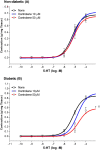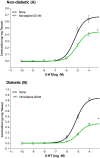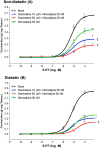The combination of dantrolene and nimodipine effectively reduces 5-HT-induced vasospasms in diabetic rats
- PMID: 33972638
- PMCID: PMC8110522
- DOI: 10.1038/s41598-021-89338-6
The combination of dantrolene and nimodipine effectively reduces 5-HT-induced vasospasms in diabetic rats
Abstract
Diabetics have a higher risk of developing cerebral vasospasms (CVSP) after subarachnoid hemorrhagic stroke than non-diabetics. Serotonin (5-HT) is one of the key vasoconstrictors released in the hemorrhagic blood and an important contributor to the etiology of CVSP. The combination of the ryanodine receptor blocker dantrolene and the Ca2+ channel blocker nimodipine significantly reduces phenylephrine (PHE)-induced vascular contraction in both diabetic and nondiabetic rats, but the effectiveness of this drug combination in reducing 5-HT-induced contraction is unknown. Dose-response curves for the 5-HT-induced contraction (from 0.1 nM to 100 µM) were performed on aortic rings from diabetic and non-diabetic rats after a 30-min incubation period with dantrolene, nimodipine, and both drugs in combination. In diabetic rats, 10 μM of dantrolene alone failed to reduce 5-HT-induced maximal contraction (Emax), but 50 μM reduced this parameter by 34% (n = 7, p < 0.05). In non-diabetic rats, by contrast, dantrolene did not modify the vascular response to 5-HT. 50 nM of nimodipine alone, however, reduced this parameter by 57% in diabetic rats (n = 10, p < 0.05), and by 34% in non-diabetic rats (n = 10, p < 0.05). In addition, concomitant administration of dantrolene and nimodipine reduced vascular reactivity to a similar extent in both diabetic (~ 60% reduction, n = 10, p < 0.05) and non-diabetic rats (~ 70% reduction, n = 10, p < 0.05). Moreover, the combination of nimodipine with the higher concentration of dantrolene significantly increased the EC50 values for the 5-HT-induced contraction curves in both diabetics (from 10.31 ± 1.17 µM to 19.26 ± 2.82; n = 10, p < 0.05) and non-diabetic rats (5.93 ± 0.54 µM to 15.80 ± 3.24; n = 10, p < 0.05). These results suggest that simultaneous administration of dantrolene and nimodipine has a synergistic effect in reducing 5-HT-induced vascular contraction under both diabetic and non-diabetic conditions. If our findings with rats are applicable to humans, concomitant administration of these drugs may represent a promising alternative for the management of CVSP in both diabetics and non-diabetics.
Conflict of interest statement
The authors declare no competing interests.
Figures



References
-
- Connolly ES Jr, Rabinstein AA, Carhuapoma JR, Derdeyn CP, Dion J, Higashida RT, et al. American Heart Association Stroke Council; Council on Cardiovascular Radiology and Intervention; Council on Cardiovascular Nursing; Council on Cardiovascular Surgery and Anesthesia; Council on Clinical Cardiology. Guidelines for the management of aneurysmal subarachnoid hemorrhage: a guideline for healthcare professionals from the American Heart Association/american Stroke Association. Stroke. 2012;43(6):1711–37. 10.1161/STR.0b013e3182587839. - PubMed
Publication types
MeSH terms
Substances
Grants and funding
LinkOut - more resources
Full Text Sources
Other Literature Sources
Miscellaneous

